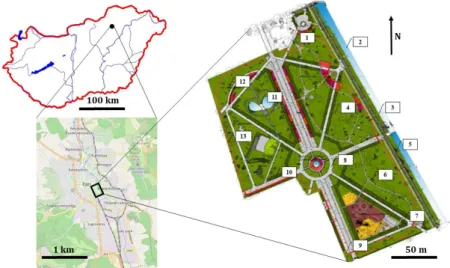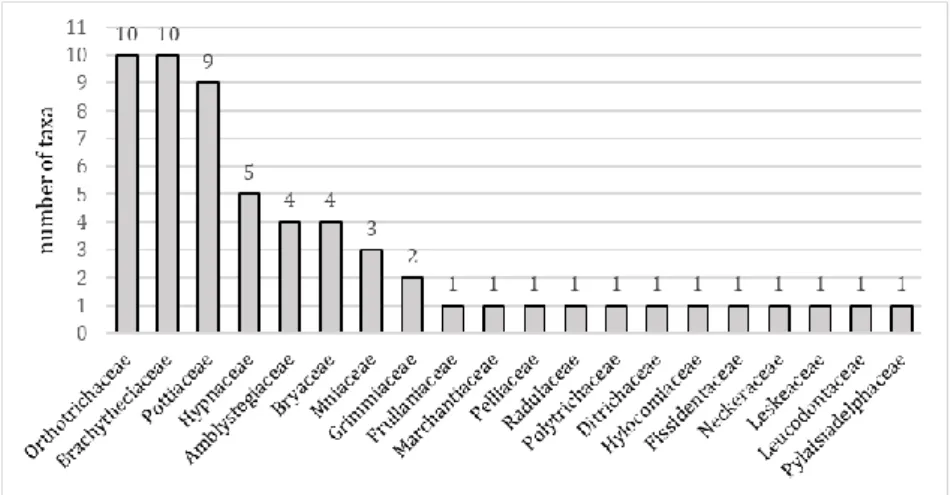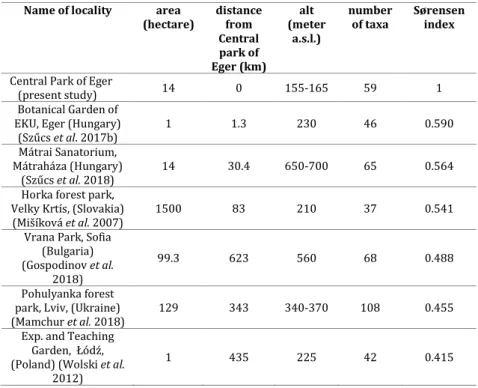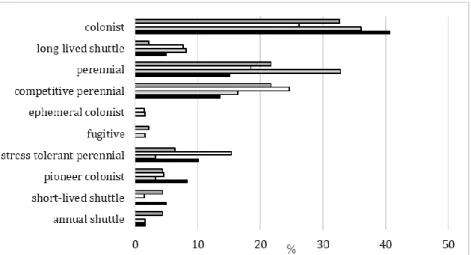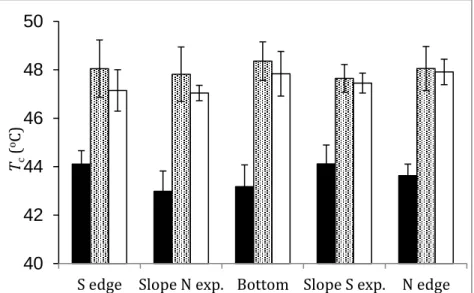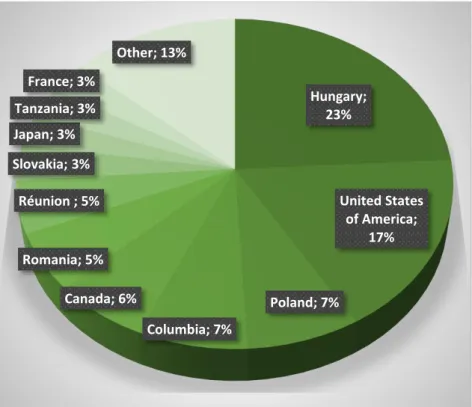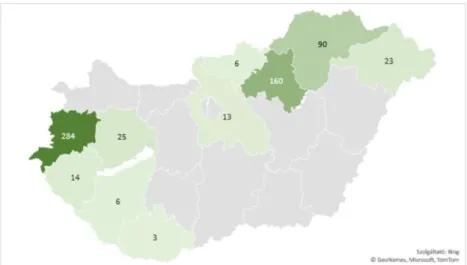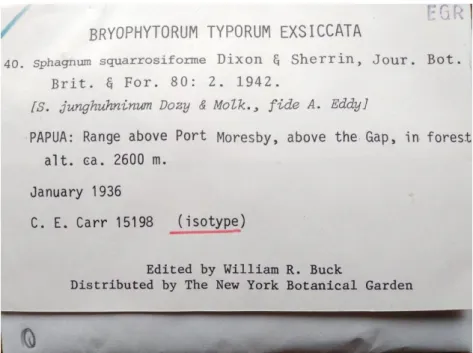ACTA BIOLOGICA PLANTARUM AGRIENSIS (ABPA)
from Acta Academiae Paedagogicae Agriensis Sectio Biologiae
a Journal of Plant Biology
TOMUS 8.
Eger 2020
Senior Editors:
Endre Lehoczky (Biophysics) László Mustárdy (Cell Biology)
Sándor Orbán (Ecology) Editorial Board:
Éva Darkó (Biotechnology)
Sándor Dulai (Physiology, Stress and Ecophysiology) Marianna Marschall (Biochemistry, Stress and Ecophysiology)
István Molnár (Molecular Biology) Márta Molnár-Láng (Genetics)
Mária Papp (Anatomy) Erika Pénzes-Kónya (Ecology) Andrea Sass-Gyarmati (Taxonomy)
Péter Szűcs (Ecology, Taxonomy) Zsolt Zsófi (Grapevine Biology and Physiology)
András Vojtkó (Geobotany) Editor:
Péter Szűcs Managing Editor:
Erika Pénzes-Kónya Technical Editors:
Péter Szűcs, Gabriella Fintha Reviewers of papers:
Beáta Bóka, Éva Darkó, Bálint Dima, Peter Erzberger, Péter Forgó†, József Geml, Andrea Sass- Gyarmati, Zoltán Murányi, László Mustárdy, Ryszard Ochyra, Tamás Pócs, Catherine Reeb,
Alfons Schäfer-Verwimp, Péter Szűcs HU ISSN 2061-6716 (Print) HU ISSN 2063-6725 (Online)
Papers of this volume are available: http://abpa.ektf.hu/
© 2020, Eszterházy Károly University, Hungary, Department of Botany and Plant Physiology A kiadásért felelős az Eszterházy Károly Egyetem rektora
Megjelent az EKE Líceum Kiadó gondozásában/Published by Líceum Publisher EKE Kiadóvezető/Head of publisher: Nagy Andor
Tördelőszerkesztő/Layout editor: Szűcs Péter Megjelent/Year of publication: 2020
Nyomdai munkák: Eszterházy Károly Egyetem nyomdája /Printed by Károly Eszterházy University Press Felelős vezető/Responsible of printing: Kérészy László
© 2020, Eszterházy Károly University, Hungary Department of Botany and Plant Physiology
Acta Biologica Plantarum Agriensis 8(1): 3–16 (2020) ISSN 2061-6716 (Print), 2063-6725 (Online) http://abpa.ektf.hu/
DOI:10.21406/abpa.2020.8.1.3 Research article
THE BRYOPHYTE DIVERSITY OF CENTRAL PARK (ARCHBISHOP’S GARDEN) OF EGER TOWN (HUNGARY)
Péter Szűcs1*, Gabriella Fintha1 & Gergő Fazekas2
1Eszterházy Károly University, Institute of Biology, Department of Botany and Plant Physiology, H-3300 Eger, Leányka u. 6, Hungary; 2Eszterházy Károly University, H-
3300 Eger, Leányka u. 6, Hungary; *E-mail: szucs.peter@uni-eszterhazy.hu Abstract: The objective of the present work was the evaluation of the bryophyte diversity of the central park of Eger town. Altogether 59 taxa (4 liverworts and 55 mosses) were recorded. Nearly half of the identified species (49%) belong to three families: Orthotrichaceae, Pottiaceae, and Brachytheciaceae. Brachythecium glareosum, Cirriphyllum piliferum, Eucladium verticillatum, Orthotrichum obtusifolium and Orthotrichum pumilum are rated near threatened (NT) according to the Hungarian Red List. Some of the taxa found in Eger were not known from other central east european urban parks (Ctenidium molluscum, Hygroamblystegium tenax, Pohlia melanodon, Cirriphyllum crassinervium, Hypnum cupressiforme var. lacunosum, Orthotrichum stramineum and Orthotrichum striatum). There are remarkable differences between central park of Eger and other Central and Eastern European parks regarding species composition and the percentage of species in each of the life strategy categories.
Keywords: downtown, urban area, Sørensen index, comparison
INTRODUCTION
There is growing recognition of urban areas as hosts for innovative ways to conserve and promote biodiversity. Parks, as one specific type of urban green space, constitute particularly important biodiversity hotspots in the cityscape (Nielsen et al. 2014).
In Central and Eastern Europe several publications address the bryophyte flora or diversity of parks and gardens in urban areas, for example Warsaw, Łódź and other Polish cities (Fudali 2006, Wolski et al. 2012), Lviv (Mamchur el al. 2018), Bucharest (Gomoiu and Ștefănuţ 2008), Veľký Krtíš (Mišíková et al. 2007), Sofia (Gospodinov et al. 2018) and Bratislava (Godovičová and Mišíková
2017). The aim of this study was the examination of the bryophyte diversity of the central park of Eger town.
Knowledge about the bryophytes of anthropogenic habitats in Hungary is limited, and the following papers focus mostly on the description of floristic data: Budapest city (Szepesfalvi 1940, 1941, 1942) Barcs (Szűcs et al. 2014), the towns of Sopron (Szűcs 2015) and Gödöllő (Király et al. 2019). The bryophyte flora of Almásfüzitő (Szűcs et al. 2017a), Balaton village (Zsólyom and Szűcs 2018), and of the manor park of Martonvásár village (Nagy et al. 2016) are well documented in Hungary. However, there are no publications aiming at completeness with respect to the bryophyte diversity of parks of downtown areas in Hungary.
MATERIALS AND METHODS
Site details descriptions include data in the following order in the Appendix: habitat, GPS-coordinates, date of collection. Based on the Central European Flora Mapping System (Király et al. 2003), each collection point belongs to the 8188.1 square. The nomenclature follows Király (2009) for vascular plants, Söderström et al. (2016) for liverworts, and Hill et al. (2006) for mosses. In order to characterise the conservation and indicator status of taxa the Hungarian Red List was used (Papp et al. 2010). We used the Sørensen index (Sørensen 1948) for the comparison of the species composition of different localities. Collected specimens are deposited at the Cryptogamic Herbarium of the Department of Botany and Plant Physiology at the Eszterházy Károly University, Eger (EGR).
Study area
The town of Eger belongs to the Eger-Bükkalja micro-region, which is a colline area at an elevation of 126 to 420 m above sea level, slightly sloping to the south-east. The settlement is situated on the terraced valley of the Eger Creek, and to a smaller extent it covers the hillside accompanying the valley of the Tárkány Creek (Sugár 1983).
It is a region with a moderately warm to moderately dry climate.
The average annual temperature is 9.0–10.0 °C at the highest points. The average annual precipitation is approximately 600 mm,
SZŰCS et al. (2020): The bryophyte diversity of central park of Eger (Hungary)
5
of which 340–380 mm is produced during the vegetation period.
The likelihood of rainfall is the highest in early summer and late autumn (Dövényi 2010, Sugár 1983).
The dominance of the North-West winds is evident in every season, which is particularly characteristic during the summer months. In terms of wind flow speed, Eger is classified into the moderately windy areas of Hungary, which is also indicated by the relatively high frequency of wind silences (Dövényi 2010, Sugár 1983). The Eger Creek forms the boundary of the park in the north- east. The groundwater of the Eger valley has particularly hard water rich in sodium-calcium-hydrogencarbonate and sulfate (Sugár 1983).
The historical descriptions from the 15th and 16th century refer to this part of our town as a rich forested area where the wildlife park was located which was probably established by a bishop of Eger from the Renaissance. The former wildlife park was much larger than today's Archbishop's Garden. It included the area of today's Thermal bath, the present Archbishop's Garden, and also the Csákó district, which extends to the present railway station.
In the park there is an ornamental garden, on the left side of the creek there is a flower garden up to the mills, and between the mills and today's Csákány street there is a vegetable garden which together formed the old bishop's garden. The episcopal ornamental garden was established during the time of Ferenc Barkóczy (1710–
1765), in the style of French gardens. In 1769 Bishop Károly Eszterházy (1725–1799) initiated the construction of a stone fence and ornate baroque gates to replace the old wooden fence. The oldest trees in the park are sycamore trees, estimated to be between 300 and 400 years old. Lajos Szmrecsányi (1851–1943) opened the gates of the 14-hectare Archbishop's Garden to the citizens of the town in 1919, and since then the area has been under significant human influence. (Herzegné Székely 2010). As for the park's maintenance, lawn mowing and leaf collection is performed regularly.
Figure 1. The situation of Eger town, and the map and collecting points of the central park of Eger.
RESULTS AND DISCUSSION List of species
Numbers refer to sites (Figure 1) listed in the Appendix. The substrates given after a colon refer to all listed sites.
Marchantiophyta
Frullania dilatata (L.) Dumort. – LC – 1: bark of Fraxinus
Marchantia polymorpha subsp. ruderalis Bischl. & Boisselier – LC – 3: rock in stream water
Pellia endiviifolia (Dicks.) Dumort. – LC - 2: rock in stream water Radula complanata (L.) Dumort. – LC – 1: bark of Sophora
japonica; 6, 7: bark of Acer negundo; 5: bark of Ailanthus altissima
Bryophyta
Amblystegium serpens (Hedw.) Schimp. – LC – 1: artifical stone; 3:
wall of the stream; 4, 5: soil; 7, 12: concrete and mown lawn Atrichum undulatum (Hedw.) P. Beauv. – LC – 7, 9: shaded soil
SZŰCS et al. (2020): The bryophyte diversity of central park of Eger (Hungary)
7
Barbula unguiculata Hedw. – LC – 1, 3, 13: shaded soil
Brachytheciastrum velutinum (Hedw.) Ignatov & Huttenen – LC – 12: concrete
Brachythecium glareosum (Bruch ex Spruce) Schimp. – NT – 3:
wall of the stream bank
Brachythecium rutabulum (Hedw.) Schimp. – LC – 1, 9: soil; 4, 5, 6: mown lawn; 10: stone fence; 11: artifical stone; 12: concrete;
13: andesit stone wall
Brachythecium salebrosum (F. Weber et D. Mohr) Schimp. – LC – 5: bark of Ailanthus altissima
Bryoerythrophyllum recurvirostrum (Hedw.) P. C. Chen – LC-att – 3: wall of the stream bank
Bryum argenteum Hedw. – LC – 1, 8, 11: artifical stone; 3: wall of the stream; 7, 8, 12: concrete; 10: stone fence
Bryum caespiticium Hedw. – LC – 1: concrete Bryum capillare Hedw. – LC – 3: soil bank
Bryum moravicum Podp. – LC – 3: wall of stream bank, bark of Tilia platyphyllos; 13: andesit stone wall; 5: bark of Ailanthus altissima
Calliergonella cuspidata (Hedw.) Loeske – LC – 11: artifical stone;
13: andesite stone wall
Ceratodon purpureus (Hedw.) Brid. – LC – 3: wall of the stream bank; 7, 8,12: concrete; 8, 10: soil
Cirriphyllum crassinervium (Taylor) Loeske & M. Fleisch – LC – 3:
wall of stream bank
Cirriphyllum piliferum (Hedw.) Grout – NT – 1: soil
Cratoneuron filicinum (Hedw.) Spruce – LC – 2: rock in stream water
Ctenidium molluscum (Hedw.) Mitt. – LC – 5: rubble
Didymodon rigidulus Hedw. – LC-att – 7, 8: concrete; 10: stone fence
Eucladium verticillatum (With.) Bruch & Schimp. – NT – 2:
artifical stone in thermal water
Fissidens taxifolius Hedw. – LC – 5, 7, 9: shaded soil
Grimmia pulvinata (Hedw.) Sm. – LC – 1, 8: artifical stone; 7, 12:
concrete; 13: andesite stone
Homalia trichomanoides (Hedw.) Brid. – LC-att – 5: rubble Homalothecium lutescens (Hedw.) H. Rob. –LC – 4, 6: soil
Homalothecium sericeum (Hedw.) Schimp. LC – 3: wall of the stream bank, 13: andesite stone wall
Homomallium incurvatum (Schrad. ex Brid.) Loeske – LC – 3: wall of the stream bank
Hygroamblystegium tenax (Hedw.) Jenn. – LC – 2: rock in stream Hygroamblystegium varium (Hedw.) Mönk. – LC-att – 11: wet soil
on lake shore
Hypnum cupressiforme Hedw.- LC – 1: artifical stone, bark of Fraxinus, and Sophora japonica 3: wall of the stream bank; 4, 5, 6, 7: soil; 13: andesite stone
Hypnum cupressiforme var. lacunosum Brid. – LC – 3: wall of the stream bank
Leskea polycarpa Ehrh. ex Hedw. – LC – 1: bark of Sophora japonica; 3, 4, 5, 6: bark of Acer negundo; 5: bark of Tilia platyphyllos
Leucodon sciuroides (Hedw.) Schwägr. – LC – 1: bark of Fraxinus Orthotrichum affine Schrad. ex Brid. – LC – 1: bark of Fraxinus;
and Sophora japonica; 4, 6: bark of Acer negundo; 5: bark of Tilia platyphyllos and Ailanthus altissima
Orthotrichum anomalum Hedw. – LC – 1: artifical stone; 3: wall of the stream bank; 13: andesite stone wall
Orthotrichum cupulatum Hoffm. ex Brid. – LC-att – 1: artifical stone; 3: wall of the stream bank
Orthotrichum diaphanum Schrad. ex Brid. – LC – 1, 4, 6: bark of Acer negundo
Orthotrichum obtusifolium Brid. – NT – 1: bark of Fraxinus; 4, 6:
bark of Acer negundo; 10: bark of Sophoria japonica
Orthotrichum pallens Bruch ex Brid. – LC – 5, 7: bark of Tilia platyphyllos; 10: bark of Sophoria japonica
Orthotrichum pumilum Sw. ex anon. – NT – 10: stone fence
Orthotrichum speciosum Nees – LC-att – 5, 7: bark of Tilia platyphyllos
Orthotrichum stramineum Hornsch. ex Brid. – LC – 5, 7: bark of Tilia platyphyllos; 10: bark of Sophoria japonica
Orthotrichum striatum Hedw. – LC-att – 5, 7: bark of Tilia platyphyllos
Oxyrrhynchium hians (Hedw.) Loeske – LC – 1, 4, 5, 6, 7, 8, 12: soil Plagiomnium cuspidatum (Hedw.) T. J. Kop. – LC – 3, 7, 9: soil Plagiomnium undulatum (Hedw.) T. J. Kop. – LC – 7, 9: soil
Platygyrium repens (Brid.) Schimp. – LC – 5: artifical stone; 7, 8:
concrete
Pohlia melanodon (Brid.) A.J. Shaw – LC – 3: soil of stream bank
SZŰCS et al. (2020): The bryophyte diversity of central park of Eger (Hungary)
9
Pylaisia polyantha (Hedw.) Schimp. – LC – 1: bark of Fraxinus; 4, 6:
bark of Acer negundo
Schistidium crassipilum H. H. Blom – LC – 1: artifical stone; 3: wall of the stream bank
Sciuro-hypnum populeum (Hedw.) Ignatov & Huttunen – LC – 3:
wall of the stream bank
Syntrichia papillosa (Wilson) Jur. – LC-att – 1: bark of Fraxinus Syntrichia ruralis (Hedw.) F. Weber & D. Mohr – LC – 3: wall of the
stream bank
Syntrichia virescens (De Not.) Ochyra – LC-att – 1: bark of Fraxinus; 3: wall of the stream bank; 10: stone fence
Tortula muralis Hedw. – LC – 1, 8, 11: artifical stone; 7, 8, 12:
concrete
Tortula truncata (Hedw.) Mitt. – LC – 7: soil Bryophyte diversity
Altogether 59 bryophytes were detected in the central park of Eger, which include 4 liverworts (7%) and 55 mosses (93%). The liverwort species belong to 4 families and 4 genera, while the mosses belong to 16 families and 32 genera (Figure 2).
Nearly half of the species (49.15%) belong to the 3 families Orthotrichaceae (10 taxa), Brachytheciaceae (10 taxa) and Pottiaceae (9 taxa).
Figure 2. Distribution of bryophyte species found in the central park of the Eger town among families (Taxonomy follows Goffinet and Shaw 2009 and Söderström et al. 2016).
Many of the common mosses of the central park of Eger, including Amblystegium serpens, Barbula unguiculata, Brachythecium rutabulum, B. salebrosum, Bryum argenteum, Ceratodon purpureus, Fissidens taxifolius, Grimmia pulvinata, Hypnum cupressiforme, Leskea polycarpa, Leucodon sciuroides, Orthotrichum affine, O. anomalum, O. diaphanum, O. pumilum, Oxyrrhynchium hians, Plagiomnium undulatum, Platygyrium repens, Pylaisia polyantha, Syntrichia ruralis and Tortula muralis have also been found in some other parks of Central East European settlements (Fudali 2006, Wolski et al. 2012, Mamchur el al. 2018, Gomoiu and Ștefănuţ 2008, Mišíková et al. 2007, Gospodinov et al.
2018 and Godovičová and Mišíková 2017).
Atrichum undulatum and Homalia trichomanoides occur in some Central East European parks (Fudali 2006, Mamchur el al. 2018) and Eucladium verticillatum was detected in the forest park of Lviv city (Mamchur el al. 2018). These three species are not known from other hungarian settlements (Szűcs et al. 2017a, Zsólyom and Szűcs 2018).
There are a few taxa in Eger, which are not known in the Central East European urban parks (Fudali 2006, Wolski et al. 2012, Mamchur et al. 2018, Gomoiu and Ștefănuţ 2008, Mišíková et al.
2007, Gospodinov et al. 2018 and Godovičová and Mišíková 2017), for example Ctenidium molluscum, Hygroamblystegium tenax, Pohlia melanodon, Cirriphyllum crassinervium, Hypnum cupressiforme var.
lacunosum, Orthotrichum stramineum and O. striatum.
Table 1 shows the values of the Sørensen index, which are derived from a comparison of moss species in the region, in Central and Eastern European parks, and the central park of Eger. The values of parks in Central and Eastern Europe are similar in this respect, there is no notable difference between the calculated data (0.415–0.590). Compared to the park of Eger, the discrepancy is most pronounced in the case of the Teaching Garden, Łódź (0.415).
The Botanical Garden or EKU is situated closest to the central park of Eger and shows the greates similarity in species composition (highest Sørensen index of 0.590).
SZŰCS et al. (2020): The bryophyte diversity of central park of Eger (Hungary)
11
Table 1. Comparison of the area, the distance of localities from Eger, the altitude, the number of taxa and Sørensen index of central east european parks with central park of Eger town.
Conservation status
Five taxa belong to the near threatened (NT) category according to the Hungarian Red List (Papp et al. 2010): Brachythecium glareosum, Cirriphyllum piliferum, Eucladium verticillatum, Orthotrichum obtusifolium and Orthotrichum pumilum. Another eight species belong to least concern attention (LC-att), viz.
Bryoerythrophyllum recurvirostrum, Didymodon rigidulus, Homalia trichomanoides, Hygroamblystegium varium, Orthotrichum cupulatum, Orthotrichum striatum, Syntrichia papillosa, and Syntrichia virescens.
Some indicator mosses (species which by their presence indicate a higher conservation value of the habitat) also occur in the park, for example Cirriphyllum piliferum, Eucladium verticillatum, Homalia trichomanoides, Hygroamblystegium varium,
Name of locality area
(hectare) distance from Central park of Eger (km)
alt (meter
a.s.l.)
number
of taxa Sørensen index
Central Park of Eger
(present study) 14 0 155-165 59 1
Botanical Garden of EKU, Eger (Hungary)
(Szűcs et al. 2017b) 1 1.3 230 46 0.590
Mátrai Sanatorium, Mátraháza (Hungary)
(Szűcs et al. 2018) 14 30.4 650-700 65 0.564
Horka forest park, Velky Krtís, (Slovakia)
(Mišíková et al. 2007) 1500 83 210 37 0.541
Vrana Park, Sofia (Bulgaria) (Gospodinov et al.
2018)
99.3 623 560 68 0.488
Pohulyanka forest park, Lviv, (Ukraine)
(Mamchur et al. 2018) 129 343 340-370 108 0.455
Exp. and Teaching Garden, Łódź, (Poland) (Wolski et al.
2012)
1 435 225 42 0.415
Orthotrichum cupulatum, O. obtusifolium, O. pumilum, O. speciosum, O. striatum, and Syntrichia papillosa.
Life strategies
There is a remarkable difference between central park of Eger and other local or regional habitats (Table 1) concerning the percentage of species in each of the life strategy categories (Dierßen 2001).
Central park of Eger is more abundant in colonists and pioneer colonists, and less abundant in long-lived shuttle, perennial, and competitive perennial species, compared to the other habitats.
None of the bryophytes in the Central park of Eger belong to the ephemeral colonist and fugitive categories (Figure 3).
A possible explanation for the above phenomenon is that abundant bare soil surface is available for the bryophytes, but disturbed substrates are very rare in the studied area.
Figure 3. Comparison of the life strategies of bryophytes in Botanical Garden of Eger (Szűcs et al. 2017b), park of Mátrai Sanatorium (Mátraháza) (Szűcs et al.
2018), Balaton village (Zsólyom and Szűcs 2018) and central park of Eger (present study).
SZŰCS et al. (2020): The bryophyte diversity of central park of Eger (Hungary)
13 CONCLUSIONS
The central park of Eger has a remarkable bryophyte diversity, which is of comparable magnitude to local, regional places and central east european urban parks in accordance with its size. The high number of indicator mosses shows a high level of conservation value of the park.
The rich bryophyte flora partly can be expained by the history of the different habitats, the abundance of old and varied deciduous trees and the proximity of Eger creek and the municipal thermal spa.
Acknowledgement – The authors would like to express their gratitude to Peter Erzberger and Andrea Sass-Gyarmati for their useful comments. The authors would like to thank Tamás Pócs for the identification of Eucladium verticillatum.
The first author’s research was supported by the grant EFOP-3.6.1-16-2016- 00001 (“Complex improvement of research capacities and services at Eszterházy Károly University”). Special thanks to András Vojtkó and András Schmotzer for their help with literature.
REFERENCES
DIERßEN, K. (2001). Distribution, ecological amplitude and phytosociological characterization of European bryophytes. Bryophytorum Bibliotheca 56: 1–
289.
DÖVÉNYI, Z. (ed.) (2010). Magyarország kistájainak katasztere. MTA Földrajz- tudományi Kutatóintézet, Budapest, 824 pp.
FUDALI,E. (2006). Influence of city on the floristical and ecological diversity of bryophytes in parks and cemeteries. Biodiversity. Research and conservation 1–
2: 131–137.
GODOVIČOVÁ,K.&MIŠÍKOVÁ,K. (2017). Epifytické machorasty urbánneho prostredia Bratislavy (Epiphytic bryophytes in the urban environment of Bratislava).
Bryonora 59: 44–57.
GOFFINET,B.&SHAW,A.J. (eds.) (2009). Bryophyte biology. Cambridge University Press, Cambridge, 565 pp.
GOMOIU, I. & ȘTEFĂNUŢ, S. (2008). Lichen and bryophytes as bioindicator of air pollution. In: CRACIUM, I. (ed.) Species monitoring in the central parks of Bucharest. Universitatea din Bucureşti, Bucharest, pp. 14–25.
GOSPODINOV,G.,LAMBEVSKA-HRISTOVA,A.,NATCHEVA,R.&GYOSHEVA,M. (2018). Vrana Park – a neglected site for bryophyte and fungal diversity in Sofia city.
Phytologia Balcanica 24(3): 323–329.
HERZEGNÉ SZÉKELY,A. (2010). Az Érsekkert története. In: RENN,O. (ed.): Egri séták nemcsak Egrieknek I. Egri Lokálpatrióta Egylet, Eger, pp. 133–147.
HILL, M.O., BELL, N., BRUGGEMAN-NANNAENGA, M.A., BRUGUES, M., CANO, M.J., ENROTH, J., FLATBERG, K.I., FRAHM, J.-P., GALLEGO, M.T., GARILLETI, R., GUERRA, J., HEDENÄS, L., HOLYOAK, D.T., HYVÖNEN, J., IGNATOV, M.S., LARA, F., MAZIMPAKA, V., MUÑOZ, J. &
SÖDERSTRÖM, L. (2006). An annotated checklist of the mosses of Europe and Macaronesia. Journal of Bryology 28: 198–267.
https://doi.org/10.1179/174328206x119998
KIRÁLY,G.,BALOGH,L.,BARINA,Z.,BARTHA,D.,BAUER,N.,BODONCZI,L.,DANCZA,I.,FARKAS, S.,GALAMBOS,I.,GULYÁS,G.,MOLNÁR,V.A.,NAGY,J.,PIFKÓ,D.,SCHMOTZER,A.,SOMLYAI, L.,SZMORAD,F.,VIDÉKI,R.,VOJTKÓ,A.,& ZÓLYOMI,SZ. (2003). A magyarországi flóratérképezés módszertani alapjai. Flora Pannonica 1: 3–20.
KIRÁLY,G. (ed.) (2009). Új magyar füvészkönyv (Magyarország hajtásos növényei, határozókulcsok). Aggteleki Nemzeti Park Igazgatóság, Jósvafő, 616 pp.
KIRÁLY,G.,BARÁTH,K.,BAUER,N.,ERZBERGER,P.,PAPP,B.,SZŰCS,P.,VERES,SZ.&BARINA,Z.
(2019). Taxonomical and chorological notes 8 (85–93). Studia botanica hungarica 50(1): 241–252.
https://doi.org/10.17110/StudBot.2019.50.1.241
MAMCHUR,Z.,DRACH,Y.&DANYLKIV,I.(2018).Bryoflora of the “Pohulyanka” forest park (Lviv city) I. Changes in taxonomic composition under anthropogenic transformation. Studia Biologica 12(1): 99–112.
https://doi.org/10.30970/sbi.1201.542
MIŠÍKOVÁ,K.,MIŠIK,M.&KUBINSKÁ,A. (2007). Bryophytes of the forest park Hôrka (Veľký Krtíš town, Slovakia). Acta Botanica Universitatis Comenianae 43: 9–13.
NAGY,Z.,MAJLÁTH,I.,MOLNÁR,M.&ERZBERGER,P. (2016). A martonvásári kastélypark mohaflórája. (Bryofloristical study in the Brunszvik manor park in Martonvásár, Hungary). Kitaibelia 21(2): 198–206.
https://doi.org/10.17542/kit.21.198
NIELSEN,A.B.,BOSCH,M.,MARUTHAVEERAN,S.&BOSCH,C.K.(2014). Species richness in urban parks and its drivers: A review of empirical evidence. Urban Ecosystems 17(1): 305–327. https://doi.org/10.1007/s11252-013-0316-1
PAPP,B.,ERZBERGER,P.,ÓDOR,P.,HOCK,ZS.,SZÖVÉNYI,P.,SZURDOKI,E.&TÓTH,Z. (2010).
Updated checklist and red list of Hungarian bryophytes. Studia botanica hungarica 41: 31–59.
SØRENSEN,T. (1948). A method of establishing groups of equal amplitude in plant sociology based on similarity of species content. Kongelige Dansk e Videnskabernes Selskab. Biologiske Skrifter 4: 1–34.
SÖDERSTRÖM,L.,HAGBORG,A., VON KONRAT,M.,BARTHOLOMEW-BEGAN,S.,BELL,D.,BRISCOE, L., BROWN, E., CARGILL, D.C., COSTA, D.P., CRANDALL-STOTLER, B.J., COOPER, E.D., DAUPHIN,G.,ENGEL,J.J.,FELDBERG,K.,GLENNY,D.,GRADSTEIN,S.R.,HE,X.,HEINRICHS,J., HENTSCHEL,J.,ILKIU-BORGES,A.L.,KATAGIRI,T.,KONSTANTINOVA,N.A.,LARRAÍN,J.,LONG, D.G.,NEBEL,M.,PÓCS,T.,PUCHE, F.,REINER-DREHWALD,E., RENNER, M.A.M., SASS- GYARMATI,A.,SCHÄFER-VERWIMP,A.,MORAGUES,J.G.S.,STOTLER,R.E.,SUKKHARAK,P., THIERS,B.M.,URIBE,J.,VÁŇA,J.,VILLARREAL,J.C.,WIGGINTON,M.,ZHANG,L.&ZHU,R.-L.
(2016). World checklist of hornworts and liverworts. PhytoKeys 59: 1–828.
https://doi.org/10.3897/phytokeys.59.6261
SUGÁR, I. (1983). Eger Gyógyvizei és fürdői. Eger Város Tanácsa V. B. Műszaki Osztálya és a Heves megyei Idegenforgalmi Hivatal kiadása, Eger, 441 pp.
SZŰCS et al. (2020): The bryophyte diversity of central park of Eger (Hungary)
15
SZEPESFALVI, J. (1940). Die Moosflora der Umgebung von Budapest und des Pilisgebirges I. Annales historico-naturales Musei nationalis hungarici 33: 1–
104.
SZEPESFALVI, J. (1941). Die Moosflora der Umgebung von Budapest und des Pilisgebirges II. Annales historico-naturales Musei nationalis hungarici 34: 1–
71.
SZEPESFALVI, J. (1942). Die Moosflora der Umgebung von Budapest und des Pilisgebirges III. Annales historico-naturales Musei nationalis hungarici 35: 1–
72.
SZŰCS, P. (2015). Kindbergia praelonga (Hedw.) Ochyra Sopron város mohaflórájában. Kitaibelia 20(2): 305.
SZŰCS,P.,BÖRCSÖK,Z.&KÁMÁN,O.(2014). A Riccia glauca L. és a Riccia sorocarpa Bisch. előfordulása Barcs belterületén. Kitaibelia 19(2): 365.
SZŰCS,P.,PÉNZES-KÓNYA,E.&HOFMANN,T. (2017a). The bryophyte flora of the village of Almásfüzitő, a former industrial settlement in NW-Hungary. Cryptogamie, Bryologie 38(2): 153–170. https://doi.org/10.7872/cryb/v38.iss2.2017.153 SZŰCS,P.,TÁBORSKÁ,J.,BARANYI,G.&PÉNZES-KÓNYA,E. (2017b). Short-term changes in
the bryophyte flora in the Botanical Garden of Eszterházy Károly University (Eger, NE Hungary). Acta Biologica Plantarum Agriensis 5(2): 52–60.
https://doi.org/10.21406/abpa.2017.5.2.52
SZŰCS,P.,BARANYI,G.&FINTHA,G.(2018). The bryophyte flora of the park of Mátrai Gyógyintézet Sanatorium (NE Hungary). Acta Biologica Plantarum Agriensis 6:
123–132. https://doi.org/10.21406/abpa.2018.6.123
WOLSKI, G.J., STEFANIAK, A. & KOWALKIEWICZ, B. (2012). Bryophytes of the experimental and teaching garden of the faculty of biology and environmental protection, University of Łódź (Poland). Ukrainian Botanical Journal 69(4):
519–529.
ZSÓLYOM,D.&SZŰCS,P. (2018). Balaton település (Heves megye) mohaflórája. (The bryophyte flora of Balaton village (Heves county, Hungary)). Botanikai Közlemények 105(2): 231–242.
https://doi.org/10.17716/BotKozlem.2018.105.2.231
(submitted: 10.12.2019, accepted: 27.04.2020)
APPENDIX Site details
1. soil, artifical stone, bark of trees (04.12.2018, 01.08.2019, 02.03.2020) N47°53’53” E20°22’46”
2. rock in stream water (14.06.2019) N47°53’52” E20°22’52”
3. wall of the stream bank, soil (14.06.2019, 03.07.2019.) N47°53’49” E20°22’54”
4. mown lawn, soil (13.03.2019., 03.07.2019) N47°53’50” E20°22’50”
5. mown lawn, soil, bark of trees (13.03.2019) N47°53’47” E20°22’56”
6. bark of trees, soil, mown lawn (17.04.2019) N47°53’46” E20°22’54”
7. mown lawn, bark of trees, concrete (11.03.2019) N47°53’41” E20°22’54”
8. artifical stone, soil, concrete (11.03.2019) N47°53’45” E20°22’50”
9. soil (11.03.2019) N47°53’40” E20°22’52”
10. stone fence, soil (11.03.2019) N47°53’44” E20°22’44”
11. artifical lake (14.06.2019) N47°53’49” E20°22’45”
12. mown lawn, concrete, soil (13.03.2019) N47°53’51” E20°22’40”
13. artifical stone wall (14.04.2019, 14.06.2019) N47°53’48” E20°22’44”
© 2020, Eszterházy Károly University, Hungary Department of Botany and Plant Physiology
Acta Biologica Plantarum Agriensis 8(1): 17–20 (2020) ISSN 2061-6716 (Print), 2063-6725 (Online)
http://abpa.ektf.hu/
DOI:10.21406/abpa.2020.8.1.17 Short communication
IRIS SIBIRICA HAS UNUSUAL, PRACTICALLY NON-DIFFERENT HEAT TOLERANCE OF PS II AT DIFFERENT GEOGRAPHICAL
EXPOSURES ON THE BÜKK-PLATEAU (NORTH-HUNGARY) Sándor Dulai1*, Réka Tarnai1, Dóra Szopkó1, Anna E-Vojtkó2,
Dóra Salamon1, Ammar Allem3 & András Vojtkó1
1Eszterházy Károly University, Department of Botany and Plant Physiology, H- 3300 Eger, Leányka u. 6, Hungary; 2Department of Botany, University of South
Bohemia, České Budějovice, Czechia; 3Biological Doctoral School, St. Stephen University, H-2011 Gödöllő, Hungary; *E-mail: dulai.sandor@uni-eszterhazy.hu Abstract: Heat tolerance of photosystem II (PSII) was examined in Siberian flag (Iris sibirica L.) living in different microhabitats of a non-forested enclosed depression surface (doline) on the Bükk-plateau. Although the microclimatic parameters of the habitats with different facing sites show sharp contrasts, there was no significant difference between the heat tolerance of PSII in leaves of I.
sibirica growing in these expositions neither in dark- nor in light-adapted state.
Keywords: Iris sibirica, heat tolerance, photosynthesis, microhabitat
INTRODUCTION
Doline vegetation is influenced by a number of factors including altitude and significant differences in microclimate or soil moisture along slopes with given exposures. Due to the zone inversion parallel to climate change, montane species are already present on the bottom and northern slopes, while on southern slopes, species that favor drier and warmer climates are common (Bátori et al.
2014). However, some species occur in both aspects of the doline despite significant differences in air temperature, air and soil humidity, which requires special adaptation/acclimation strategies, especially against the temperature. In this paper, we present some preliminary results on the unusual, practically non-different heat tolerance of I. sibirica growing in different exposures.
MATERIALS AND METHODS
Leaves of Siberian flag (Iris sibirica L.) were collected from five different geographical exposition (bottom, N/S facing slopes, and N/S edge) of the second biggest non-forested doline in the Bükk- plateau (North-Hungary) between six and seven am. The collected leaves were immediately wrapped in wet filter paper and transported to the laboratory within half an hour. The in vivo heat induced chlorophyll a fluorescence was measured in dark- and light-adapted state of leaves with a pulse amplitude modulated fluorometer (IMAGING PAM M-series, Walz, Effeltrich, Germany).
The leaves were dark-adapted for 30 min, and then placed on the thermoelectric module. The minimum chlorophyll fluorescence (F0) was monitored in leaf discs exposed to elevated temperature from 25°C to 49-55°C at a rate of 1°C min-1. Recording of the steady-state fluorescence (Fs) v. T curves started when the photosynthesis was steady at 200 and 1,000 μmol m-2 s-1 actinic light intensity. Critical temperature (Tc) values were determined as the interception of regression lines fitted to F0 and Fs data.
Figure 1. Critical temperature (Tc) values of F0 (filled bars) and Fs v. T curves at 200 (semi closed bars) and 1000 (empty bars) mol m-2 s-1 acinic light (AL) intensities in leaves of Iris sibirica growing in different facing parts of the doline.
40 42 44 46 48 50
S edge Slope N exp. Bottom Slope S exp. N edge Tc(oC)
DULAI et al. (2020): Unusual heat tolerance of Iris sibirica
19 RESULTS AND DISCUSSION
The heat sensitivity of the photosynthetic apparatus is closely connected to the thermal stability of PSII, which is well characterised by critical values of the temperature dependence of the initial fluorescence (F0) level in dark-adapted leaves (Dulai et al.
1998, Szopkó and Dulai 2018). There was no significant difference in the heat tolerance of PSII determined by the Tc values of the F0 v.
T curves (recorded practically in darkness) in leaves of I. sibirica living in different expositions and it was not sufficient for tolerating such high temperatures that are peculiar to the microhabitat of S facing slope above the surface (Figure 1). Similarly to F0, the breakpoints (Tc) of temperature dependence of steady state fluorescence (Fs) appropriately show the thermal stability of samples at steady-state photosynthesis level in light adapted state (Molnár et al. 1998). In connection with this, Tc values of Fs v. T curves measured at 200 and 1000 μE m-2 s-1 actinic light intensity are shifted towards significantly higher temperatures (~47-48 oC), indicating the higher thermal tolerance of PSII (Figure 1). This is consistent with those observations that light stimulates the thermal stability of the PSII (Molnár et al. 1998, Dulai et al. 2006). However, ground level air temperatures on the S-facing slope can often exceed 47-48 oC with extreme daily fluctuations. So this reduced heat sensitivity is just enough to tolerate the high temperature conditions of the S-facing slope during the daytime period of a summer day. At the same time, the doline micro-habitats with different exposures are characterized by sharp and significant microclimatic variation (Bátori et al. 2019). These differences are manifested not only in the average daily means of ground level air temperature but also in daily maxima, daily range and air and soil moisture. As a result, more cool-adapted plants are found on the north-facing slopes and bottoms of dolines (Bátori et al. 2017).
However, some species, like Siberian flag, occur in both aspects of the depression despite the above mentioned differences in environmental factors, which should require a very plastic phenotypic performance to temperature conditions. This would also require optimizing the heat stability of the photosynthetic apparatus according to the factors specific to the given exposure.
Thus, it is very unusual for a plant to occur in all micro-habitats of
the doline but not to be able to change its temperature tolerance neither in dark- nor in light-adapted state. Consequently, as the forecasted climatic extremities increase, this plant might disappear completely from the southern slope.
Acknowledgement ‒ The first author’s research was supported by the grant EFOP-3.6.1-16-2016-00001 (“Complex improvement of research capacities and services at Eszterházy Károly University”).
REFERENCES
BÁTORI,Z.,E-VOJTKÓ,A.,ERDŐS,L.&VOJTKÓ,A. (2014). Temperature and soil moisture regimes of the forested and non-forested dolines of the Bükk Mountains based on ecological indicator values (in Hungarian). Kitaibelia 19: 331–338.
BÁTORI,Z.,VOJTKÓ,A.,MAÁK,I.E.,LŐRINCZI,,G.,FARKAS,T.,KÁNTOR,N.,TANÁCS,E.,KISS, P.J.,JUHÁSZ,O.,MÓDRA,G.,TÖLGYESI,CS.,ERDŐS,L.,AGUILON,D.J.&KEPPEL,G. (2019).
Karst dolines provide diverse microhabitats for different functional groups in multiple phyla. Nature Scientific Reports 9: 1–13. 7176.
https://doi.org/10.1038/s41598-019-43603-x
BÁTORI,Z.,VOJTKÓ,A.,FARKAS,T.,SZABÓ,A.,HAVADTŐI,K.,E-VOJTKÓ,A.,TÖLGYESI,CS., CSEH, V., ERDŐS, L., MAÁK, I.E. & KEPPEL, G. (2017). Large- and small-scale environmental factors drive distributions of cool-adapted plants in karstic microrefugia. Annals of Botany 119: 301–309.
http://dx.doi.org/10.1093/aob/mcw233
DULAI,S.,MOLNÁR,I.&LEHOCZKI,E. (1998). Effects of growth temperature of 5 and 25
°C on long-term responses of photosystem II to heat stress in atrazine- resistant and susceptible biotypes of Erigeron canadensis (L.). Australian Journal of Plant Physiology 25: 145–153.
https://doi.org/10.1071/PP97112
DULAI,S.,MOLNÁR,I.,PRÓNAY,J.,CSERNÁK,Á.,TARNAI,R.& MOLNÁR-LÁNG,M. (2006).
Effects of drought on photosynthetic parameters and heat stability of PSII in wheat and in Aegilops species originating from dry habitats. Acta Biologica Szegediensis 50: 11–17.
MOLNÁR,I.,CSIZI,K.,DULAI,S.,DARKÓ,É.&LEHOCZKI,E. (1998). Light dependence of thermostability of photosynthetic apparatus. In: GARAB,G. (ed.): Photosynthesis:
Mechanisms and Effects. Kluwer Academic Publishers, Dordrecht, pp. 2241–
2244. https://doi.org/10.1007/978-94-011-3953-3_524
SZOPKÓ,D.&DULAI,S. (2018). Environmental factors affecting the heat stability of the photosynthetic apparatus. Acta Biologica Plantarum Agriensis 6: 90–107.
https://doi.org/10.21406/abpa.2018.6.90
(submitted: 17.03.2020, accepted: 24.04.2020)
© 2020, Eszterházy Károly University, Hungary Department of Botany and Plant Physiology
Acta Biologica Plantarum Agriensis 8(1): 21–28 (2020) ISSN 2061-6716 (Print), 2063-6725 (Online)
http://abpa.ektf.hu/
DOI:10.21406/abpa.2020.8.1.21 Research article
BRYOPHYTE COLLECTION IN THE HERBARIUM OF ESZTERHÁZY KÁROLY UNIVERSITY (EGR): THE DIGITAL
DATABASE OF PEAT MOSS (SPHAGNUM) SPECIES Dávid Kapi1* & Andrea Sass-Gyarmati2
1Kozma Andor u. 6, H-3516 Miskolc, Hungary; 2Eszterházy Károly University, Institute of Biology, Department of Botany and Plant Physiology, H-3300 Eger,
Leányka u. 6, Hungary; *E-mail: kapidavid97@gmail.com
Abstract: The paper describes the Sphagnum peatmoss collection in the cryptogamic herbarium of the Eszterházy Károly University (EGR), Eger (Hungary), according to its condition in 2012. All specimens of the peatmosses were documented by digital photographs (2835 specimens), and all data from the labels were entered into MS Excel spreadsheet. 24 % of the specimens were collected in present-day Hungary, the majority of specimens comes mainly from the neighbouring countries, but more distant European lands are represented as well as overseas continents. Hungarian specimens were collected mostly in Vas, Heves, Borsod-Abaúj-Zemplén, Veszprém and Szabolcs-Szatmár-Bereg counties, areas with relatively more humid climate than the average of Hungary. Most of the herbarium sheets originated between 1950-1990’s. Apart from these periods the collection has hardly developed. The most prolific Hungarian collectors were:
Ádám Boros, László Vajda, Tamás Pócs, Márton Balogh and Ilona Gelencsér. In addition to this, many specimens were collected by foreigners as: Richard E.
Andrus, Antoine M. Cleef, Josef Duda, Adam Stebel, etc. The digital photographs and the database are property of the Department of Botany and Ecology of Eszterházy Károly University.
Keywords: biological collections, Sphagnum collection, herbarium digitization, natural history collections
INTRODUCTION
The herbarium of the Eszterházy Károly University (Index Herbariorum acronym: EGR, Index Herbariorum 2020) is the second largest herbarium in Hungary (Takács et al. 2014), consisting of two main parts. The cryptogam collection, which is one of the largest in Central Europe (200000 mosses and liverworts, and 8000 lichens) is widely known among bryologists. It
has gained an international reputation for the collections of Tamás Pócs and his colleagues, who studied and collected bryophytes all over the tropics. This collection comprises mainly lichens from Europe and Africa, but the main part are the bryophytes collected predominantly in the tropical regions of Africa, India, Indonesia, Vietnam, Papua New Guinea, Australia, Fiji, Cuba, Peru and Venezuela (Index Herbariorum 2020). The vascular collection is quite small in number, but not negligible (Sass-Gyarmati and Vojtkó 2010; Pénzesné Kónya et al. 2013). It is mainly valued for the age of its specimens, dating back to the early 19th century. It stores the collections of significant Hungarian botanists of that time, providing information about their trips and interests in certain regions or taxa. The vascular collection includes vouchers collected primarily in the territory of present-day Hungary and the neighboring countries (mainly in the Carpathian Basin), but there are specimens from the Alps, Silesia, the Balkan, and from the coastal regions of the Adriatic Sea as well. Only the vascular collection has been digitized up to now (E. Vojtkó et al. 2014).
Therefore, the digitization and analysis of the cryptogamic herbarium is still an actual challenge. We started this work in 2016 and our preliminary results were presented (Sass-Gyarmati et al.
2017). Our aim was to create a database of the Sphagnum species belonging to the cryptogamic collection of EGR, including all the main attributes of each herbarium specimen, accompanied by digital photos, which may be useful for floristic research. Currently, some other Hungarian herbaria are being processed similarly, e.g.
BP (Hungarian Natural History Museum) (Papp and Rajczy 1998), DE (Szarvas et al. 2010).
MATERIAL AND METHODS
The database comprises attributes of the material collected until 2012. Methods of digitization and database building process mostly followed Molnár V. et al. (2012) and Takács et al. (2014). The nomenclature of the species follows Michaelis (2019). Firstly, digital photographs were taken from each sheet, presenting the specimen and the label. The digital photos were taken using ‘.jpg extension, and their average size is 2–2.5 MB. The information on the labels was entered into Ms Excel spreadsheet, where rows
KAPI &SASS-GYARMATI (2020): The digital database of Sphagnum species
23
correspond to individual records and columns represent attributes of the collected specimens. The following attributes were recorded:
(1) taxon name on the label, (2) collector, (3) reviewer, (4) locality, (5) altitude of locality, (6) year of gathering, (7) month of gathering, (8) day of gathering, and (9) filename of digital photo. One record of the database represents specimen(s) of the same taxon collected from the same locality at the same time on one sheet. If a herbarium sheet contains specimens either of different taxa or from a different locality or time, they are treated as separate records. Thus, the number of records (= rows in the database) is not equal to the number of herbarium sheets (= number of digital photos). When more than one settlement is given on the label, and the administrative affiliation of the locality is therefore ambiguous, the first settlement is provided as the location of gathering (e.g. in the case of “ In picetis uliginosis inter pag. Rábatótfalu et Apátistvánfalva;”, the administrative affiliation in the database is Rábatótfalu).
If collecting dates were given as intervals (very often in case of foreign collections) we record the earlier one. Data of Sphagnum database are summarized in an electronic appendix http://biologia.uni-eger.hu/en/biology/egr/database including:
catalogue number, taxon name, collector, settlement, date of gathering and file name of the documentary photograph). Further data can be required from the curator of the herbarium.
RESULTS AND DISCUSSION Geographical coverage
The database contains 2835 records altogether, and only 24% of the records (624 records) originates from Hungary, the rest comes from the neighboring and the overseas countries (USA: 17%, Poland: 8 %, Columbia: 8%, Romania: 6%, etc.) (Figure 1). We could not identify the country of origin in 368 further records (13%), though it is more than probable that these specimens were collected outside Hungary.
Figure 1. The number of collected specimens per countries.
Our analyses reveals that Sphagnum specimens collected in present-day Hungary (624 records) originated from only a smaller part of the country. Some counties are relatively overrepresented due to the special interests of the most prolific collectors of the herbarium and also probably due to the special researches conducted in peaty area and last but not least due to the climatic conditions.
The Sphagnum specimens of EGR under study were collected between 1850 and 2012. The intensity of collecting was very uneven, as the vast majority of specimens were obtained between 1950-1990 (Figure 3).
Hungary;
23%
United States of America;
17%
Poland; 7%
Columbia; 7%
Canada; 6%
Romania; 5%
Réunion ; 5%
Slovakia; 3%
Japan; 3%
Tanzania; 3%
France; 3%
Other; 13%
KAPI &SASS-GYARMATI (2020): The digital database of Sphagnum species
25
Figure 2. The number of collected specimens per counties in Hungary.
Figure 3. The number of collected specimens per decades.
Representations of the Sphagnum species and floristically significant records
More than 130 species, subspecies and varieties occur in the Sphagnum genus worldwide (Michaelis 2019). Some of the commonest species which occurs in the herbarium (EGR) are:
Sphagnum capillifolium (Ehrh.) Hedw., Sphagnum compactum DC.
ex. Lam. & DC., Sphagnum cuspidatum Ehrh. ex. Hoffm., Sphagnum fimbriatum Wilson and Sphagnum girgensohnii Russow. The two oldest Sphagnum specimens were collected by Weselsky in 1852, from Königgrätz and by J. E. Zetterstedt in June 23, 1860 from Sweden. Apart from the exsiccata specimens of Sphagnotheca Boreali-americana (Ed. R. E. Andrus and D.H. Vitt) we preserve the isotype of Sphagnum amoenum Warnst. (Bryotheca brasiliensis) and an isotype of Sphagnum squarrosiforme Dixon and Sherrin (Bryophytorum typorum exsiccata) in our collection (Figure.4, 5).
Figure 4. Isotype of Sphagnum amoenum Warnst. (foto: A. Sass-Gy.)
KAPI &SASS-GYARMATI (2020): The digital database of Sphagnum species
27
Figure 5. Isotype of Sphagnum squarrosiforme Dixon & Sherrin. (foto: A. Sass-Gy.)
CONCLUSIONS
In the Sphagnum collection, the specimens from Hungary are not separated from the foreign specimens, but can be found in a common storage cabinet. Only 24 % of the Sphagnum specimens comes from Hungary, and the other specimens comes as exchange or gift material to the herbarium through foreign researchers or collections made by Botany Department members (Madagascar 1994, 1996 and Réunion 1996). The greatest significance of the completed database is that the Sphagnum collection of the Herbarium is now electronically searchable, which facilitates the research work and more efficient management of the collection.
Based on the database, which is also available online, the species, country, collector name and year of the Sphagnum specimens are now searchable. For more detailed data contact of the herbarium curator is required, who can assign additional data and borrow the material if necessary. Domestic and foreign herbariums can also access the data, which can help with loaning between herbaria and provide information on the size and diversity of the herbarium
